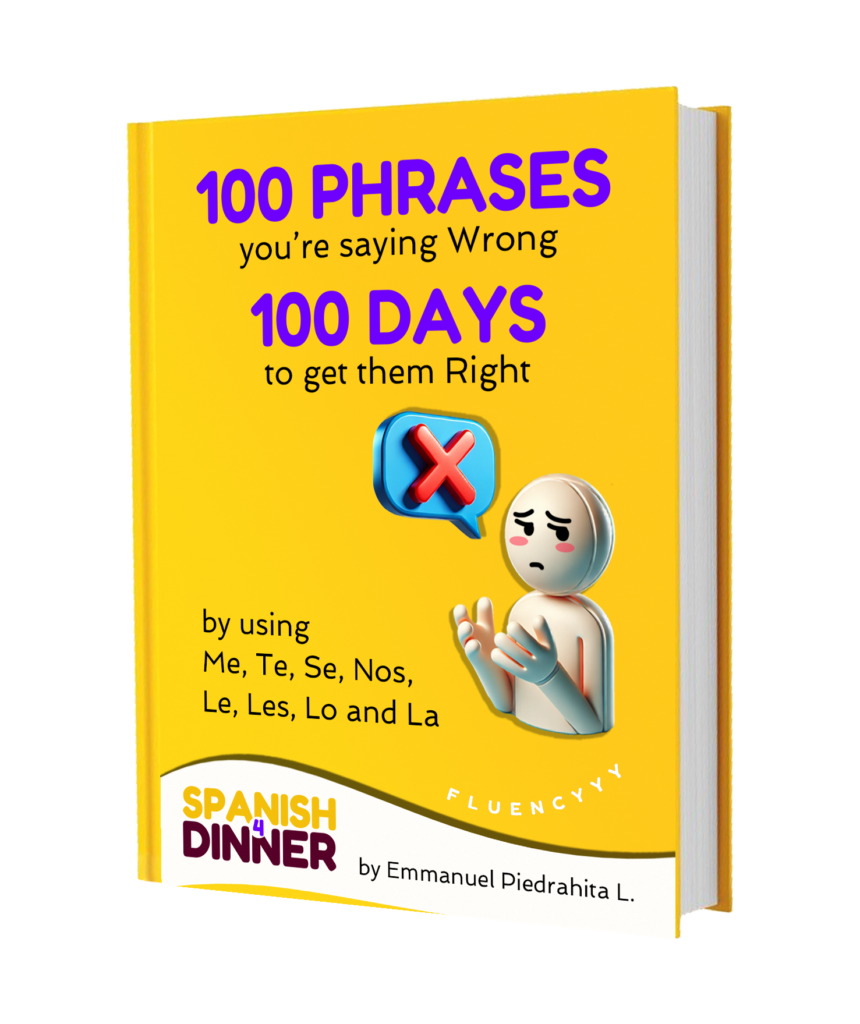Indirect object ‘me‘ and ‘a mí’ in Spanish
In this guide, you’ll learn:
🟢 How to use ‘me’ in realistic sentences as an indirect object pronoun.
🟢 The difference between ‘me’ and ‘a mí’ as indirect object pronouns.
The first thing you have to understand is there are 3 types of verbs in Spanish:

me gusta-type verbs
- me gusta (I like)
- me encanta (I love)
- me interesa (I´m interested)

‘normal’-type verbs
- yo amo (I love)
- tú necesitas (you need)
- ella tiene (she has)

reflexive verbs
- me despierto (I wake up)
- me amo (I love myself)
- me acerco (I approach)
Even though they all begin with ‘I’ in English, Spanish conjugation varies depending on the intended meaning and the level of formality or casualness in speech.
In this post, we’ll focus on the second category: ‘normal’ -type verbs. You’ll learn how to use ‘me’ and ‘a mí’ with these.
Indirect object ‘me’ and ‘a mí’ technical explanation
Imagine you’re talking to your girlfriend, María, and you want to say: “María, you need me”
How would you say this in Spanish?

Answer
María, tú me necesitas a mí | María, you need me
Or simply: me necesitas | You need me
By following the next 4-step method, you can build natural-sounding sentences in Spanish with confidence!
Step 1. Identify the performer of the action / the doer

You have to ask yourself who is performing the action? The person who is needing. (Remember, as you are talking to maria, maria is your “you” second-person singular)

Step 2. To whom is the action directed?

Identify what is the direction of the action. This is where the indirect object pronoun comes in.
In “María, you need me” the action is directed at you, the speaker (first person singular).
So, the correct direction (indirect object pronoun) is: ‘me’

Step 3. Identify the verb

Conjugate the verb necesitar based on who is the performer (the doer) of the action.

Tú necesitas ➡️ You need
Putting it all together so far:

Step 4. Identify the destination

Now ask: Who is the recipient of the action/verb?
This is also known as the indirect object.
We use ‘a mí’ to emphasize that the action is directed toward me (first person singular).
Maria´s action is directed at you, as the first person singular.
Maria´s Needs you, as the speaker.
So, the corresponding destination (indirect object) is: ‘a mí’

Final result
María, tú me necesitas a mí | María, you need me
Or simply: me necesitas | You need me
Common mistakes when using the indirect object ‘me’ and ‘a mí’
You might be wondering:
What’s the difference between ‘me’ and ‘a mí’?
‘Me’ translates to me and is placed before the verb, as you saw in Step 2.
‘A mí’ can also be translated as me, but it comes after the verb, as explained in Step 4.
Don’ts
❌ Tú necesitas me
❌ Tú necesitas mí
❌ Tú mi necesitas
❌ Tú necesitas a me
I usually recommend avoiding word-for-word translation, as it often causes confusion. A better approach is to internalize the 4-step method you’ve just learned—it’s a reliable way to build clear and natural Spanish sentences with the correct indirect object pronouns:

Important note. Remember that the verb goes according who the performer of the action / the doer is:



Still stuck in translator mode when speaking Spanish? Time to upgrade!
Our brand new course is here to help you use pronouns like me, te, nos, le, les, lo, and la with confidence — and sound way more fluent.
When to use a mí ?
❓What is the difference between tú me necesitas and tú me necesitas a mí?
There’s none, the second one is just more emphatic. Let see how:
Imagine you’re talking to your younger child. He’s upset because I’m stricter with him than with his older brother.
🔹You say: “Your older brother doesn’t need me, but you do need me, kid!”
🔹You say: Tu hermano mayor no me necesita, pero tú sí me necesitas a mí, niño!
We use a mí here to emphasize the contrast between someone who doesn’t need you and someone who truly does. It highlights the emotional weight and personal importance of the message.
❓Is one more formal than the other?
No. It´s not about formality or respect.
🥳🥳🥳
Now that you’ve understood the basics of building natural and realistic sentences in Spanish using the pronouns ‘me’ and ‘a mí’, let’s go through a couple more examples to make sure this knowledge really sticks!
Example 1
You have two kids, Cami and Dani, and you think to yourself: “-Cami and Dani need me “.
How to say that in Spanish?

Answer
Cami y Dani me necesitan a mí | Cami and Dani need me
Or simply: Cami y Dani me necesitan | Cami and Dani need me
Example 2
Imagine you want to say: “My parents love me”. How would you say that in Spanish?

Answer
Mis padres me aman a mí | My parents love me
Or simply: Mis padres me aman | My parents love me
⭐Quiz 1
Using the verb necesitar (to need), how would you say
“My boss needs me” in Spanish?
- Check out the conjugation forms for necesitar below.
- Take a minute to think about your answer before choosing an option.
- And don’t feel bad if it’s harder than you thought— that just means you’re learning!


➡️ Ready to master Spanish pronouns beyond this guide?
Our full course takes your understanding to the next level!
At Spanish4dinner, we’ve got you covered when it comes to mastering Spanish pronouns.

Grab your free 100 phrases you’re saying wrong 100 days to get them right eBook and start building a habit that will make your Spanish sound more natural—just like a local!